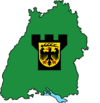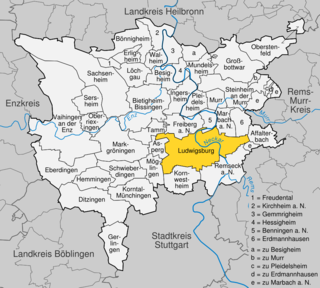
Ludwigsburg is a city in Baden-Württemberg, Germany, about 12 kilometres (7.5 mi) north of Stuttgart city centre, near the river Neckar. It is the largest and primary city of the Ludwigsburg district with about 88,000 inhabitants. It is situated within the Stuttgart Region, and the district is part of the administrative region (Regierungsbezirk) of Stuttgart.

Ludwigsburg Palace, nicknamed the "Versailles of Swabia", is a 452-room palace complex of 18 buildings located in Ludwigsburg, Baden-Württemberg, Germany. Its total area, including the gardens, is 32 ha – the largest palatial estate in the country. The palace has four wings: the northern wing, the Alter Hauptbau, is the oldest and was used as a ducal residence; the east and west wings were used for court purposes and housing guests and courtiers; the southern wing, the Neuer Hauptbau, was built to house more court functions and was later used as a residence.
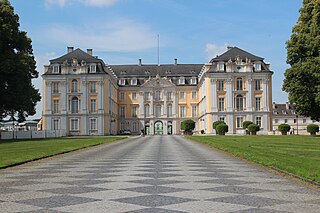
The Augustusburg and Falkenlust Palaces form a historical building complex in Brühl, North Rhine-Westphalia, Germany. The buildings are connected by the spacious gardens and trees of the Schlosspark. Built in the early 18th century, the palaces and adjoining gardens are considered masterpieces of early rococo architecture and have been listed as a UNESCO cultural World Heritage Site since 1984. Augustusburg Palace and its parks also serve as a venue for the Brühl Palace Concerts.

The Nymphenburg Palace is a Baroque palace situated in Munich's western district Neuhausen-Nymphenburg, in Bavaria, southern Germany. Combined with the adjacent Nymphenburg Palace Park it constitutes one of the premier royal palaces of Europe. Its frontal width of 632 m (2,073 ft) even surpasses Versailles Palace. The Nymphenburg served as the main summer residence for the former rulers of Bavaria of the House of Wittelsbach.

Solitude Palace is a Rococo schloss and hunting retreat commissioned by Charles Eugene, Duke of Württemberg. It was designed by Johann Friedrich Weyhing and Philippe de La Guêpière, and constructed from 1764 to 1769. It is located on an elongated ridge between the towns of Leonberg, Gerlingen and Stuttgart in Baden-Württemberg.

The New Palace is an 18th-century Baroque palace in Stuttgart and is one of the last large city palaces built in Southern Germany. The palace is located in the on the Schlossplatz in front of the Jubiläumssäule column and Königsbau. Public tours of the building are only permitted by special arrangement, as the building contains some government offices. Once a historic residence of the Kings of Württemberg, the New Palace derives its name from its commissioning by Duke Carl Eugen of Württemberg to replace the Old Castle in the early years of his reign. Originally, Charles commissioned Nikolaus Friedrich Thouret, but architects Leopoldo Retti, Philippe de La Guêpière, Reinhard Heinrich Ferdinand Fischer would contribute to the design, history, and construction of the palace.
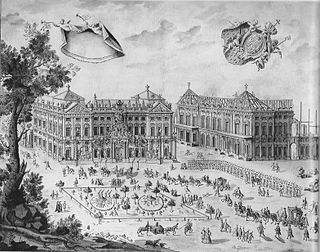
Residenz is a German word for "place of living", now obsolete except in the formal sense of an official residence. A related term, Residenzstadt, denotes a city where a sovereign ruler resided, therefore carrying a similar meaning as the modern expressions seat of government or capital. As there were many sovereign rulers in the Holy Roman Empire, ranking from Lord (Herr) to prince elector and king, there are many cities, palaces, and castles in this territory which used to be a residenz and are partially still so referred to today. The former residenz status of a city is frequently reflected by the architecture of its center. During the baroque period especially, many prestigious buildings were erected, sometimes even new towns were founded. Today, former Residenzstädte mostly still serve as cultural and administrative centers.
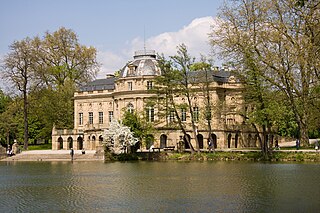
Monrepos is a lakeside schloss in Ludwigsburg, Germany. Although quite far and almost separate from Favorite Palace and Ludwigsburg Palace, it is connected to the rest of the grounds by way of pedestrian paths. It is one of the two minor palaces on the estate, along with the main one. The smaller ones were used as hunting lodges.

Fürstenried Palace is a Baroque maison de plaisance and hunting lodge in Munich, Germany. It was built from 1715 to 1717 for Elector Maximilian II Emanuel. Today the palace serves as spiritual house for archdiocese and as pastoral center.
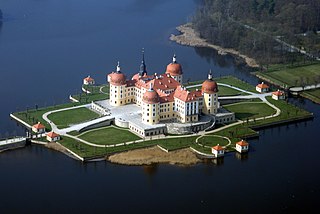
Moritzburg Castle or Moritzburg Palace is a Baroque palace in Moritzburg, in the German state of Saxony, about 13 kilometres (8.1 mi) northwest of the Saxon capital, Dresden. The castle has four round towers and lies on a symmetrical artificial island. It is named after Duke Moritz of Saxony, who had a hunting lodge built there between 1542 and 1546. The surrounding woodlands and lakes were a favourite hunting area of the electors and kings of Saxony.

Mannheim Palace is a large Baroque palace in Mannheim, Baden-Württemberg, Germany. It was originally the main residence of the Prince-electors of the Electorate of the Palatinate of the House of Wittelsbach until 1777. Part of the palace is used today by the University of Mannheim. The castle, which features tapestries, furniture, paintings, porcelain and silverware can be visited on a free-flow basis with audioguides.

Weikersheim Palace is a palace in Weikersheim, Baden-Württemberg, Germany. It was a medieval seat and later a Renaissance residence of the princely House of Hohenlohe.

Schloss Favorite is a schloss on the outskirts of Rastatt-Förch in Baden-Württemberg, Germany.
Schloss Hohenheim is a manor estate in Stuttgart, eponymous of the Hohenheim city district. The original castle was a fief of the County of Württemberg, recorded for the 12th century. The estate fell into the possession of Charles Eugene, Duke of Württemberg in 1768, who had it re-built as a Rococo style manor with extensive gardens and residential palace for his future wife, Franziska von Hohenheim. The estate was the main ducal residence during 1772–1797, when it fell to the city of Stuttgart. An Agricultural Educational Testing and Model Institution was housed here in 1818, and the estate remains in use by the Horticulture and Agriculture Departments of the University of Hohenheim.

Schloss Kirchheim is a castle and palace in the old town of Kirchheim unter Teck, in the German state of Baden-Württemberg. The palace was built in the 16th century by Ulrich, Duke of Württemberg as a castle and part of a greater system of defensive works. Over two centuries later, it became the dower house for the Duchy and later Kingdom of Württemberg. The palace's interior is currently arranged and furnished as it was during the residence of its final dowager, Henriette von Nassau-Weilburg.

Schloss Rastatt, also known as Residenzschloss Rastatt, is a Baroque schloss in Rastatt, Germany. The palace and the garden were built between 1700 and 1707 by the Italian architect Domenico Egidio Rossi for Margrave Louis William of Baden-Baden. Visitors can tour the restored Baroque interior and gardens.

Schloss, formerly written Schloß, is the German term for a building similar to a château, palace, or manor house.

In Renaissance and Early Modern German architecture, a Lustschloss is a small country house or palace which served the private pleasure of its owner, usually the ruler of the area it is located in, and was seasonally inhabited as a respite from court ceremonies and state duties. In France, the Château de Madrid in the Bois de Boulogne, easily reached from Paris, arguably set an example, and Louis XIV similarly holidayed annually from the Palace of Versailles to his nearby Château de Marly, and more frequently used his Grand Trianon, to which the Petit Trianon was added in the following century.
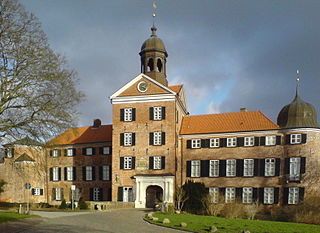
Eutin Castle in Eutin in the north German district of Ostholstein is the cultural centre and nucleus of the town. Taken together, this castle, Gottorf Castle and Glücksburg Castle, form the most important group of courtly secular buildings in the state of Schleswig-Holstein.

Callenberg Castle is a castle on a wooded hill in Beiersdorf, an Ortsteil of Coburg, 6 kilometres (3.7 mi) from the town centre. It was a hunting lodge and summer residence and has long been the principal residence of the House of Saxe-Coburg and Gotha. It is currently owned by Andreas, Prince of Saxe-Coburg and Gotha who created the Ducal Saxe-Coburg and Gotha House Order. A large and architecturally important family chapel is contained within.























